Bassdozer's Flat Shakey Jigs with Clip-on
Corkscrew Keepers

by Russ Bassdozer
This shows and tells product photos, product descriptions and
information for the lure models and colors that are (or have
been) available at BassdozerStore.com. Not all models and colors
shown are currently available, and exact specifications are
subject to change.
Note: Some of the following configurations may not all be
currently in stock. Some may be sold out at this time. Please
check online at www.BassdozerStore.com
for current availability of specific items below. Thank you for
your business.
Bassdozer's Flat Shakey Jigs with Clip-on Corkscrew Keepers
Style: Shakey Jig. Flat-Faced. Stand Up.
Football Head.
Sizes:: 3/16 oz (4/0), 1/4 oz (5/0), 3/8 oz (5/0), 1/2 oz
(6/0)
Hook: Mustad Ultra Point. Long shank. Black nickel finish.
Keeper: Clip-on wire corkscrew (clips into hook eye)
Quantity: 5 per pack with keeper clips

3/16 oz (4/0) Flat Shakey Jig ~ Black ~ Qty: 5 pack

1/4 oz (5/0) Flat Shakey Jig ~ Black ~ Qty: 5 pack
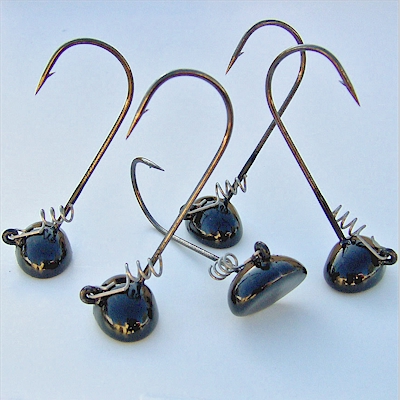
3/8 oz (5/0) Flat Shakey Jig ~ Black ~ Qty: 5 pack
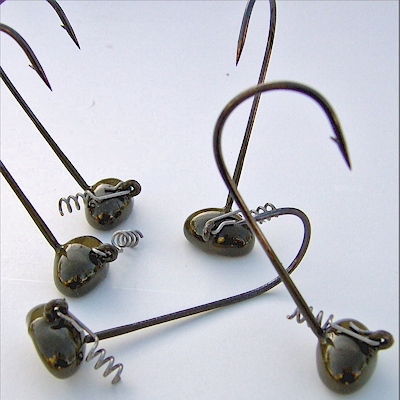
3/16 oz (4/0) Flat Shakey Jig ~ Green Pumpkin ~ Qty: 5 pack
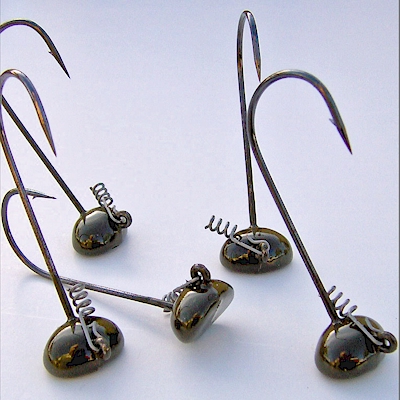
1/4 oz (5/0) Flat Shakey Jig ~ Green Pumpkin ~ Qty: 5 pack
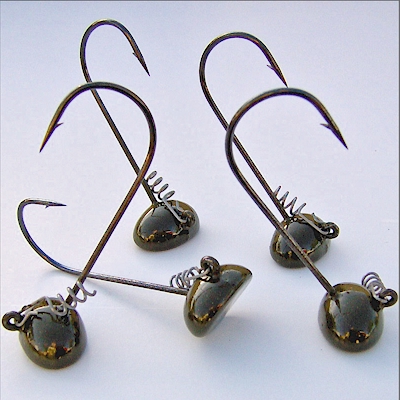
3/8 oz (5/0) Flat Shakey Jig ~ Green Pumpkin ~ Qty: 5 pack
As far as I know, these are one of the original stand up
football style shakey jigs. I know this because the company that
molds mine, also molds many other brands on the market. This was
the first they made of a shakey football style. They recommended
I make the football shape because it had not been done before,
and I liked the idea that it would be a new and original product.
There were fully-round and half-round (flat bottom) ball head
shakey jigs at the time, but no football or flat football
shakeys, to our knowledge.
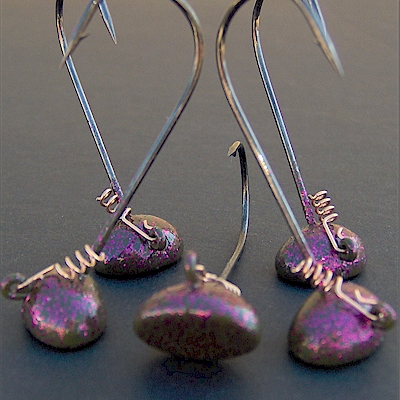
Obviously they can stand up, but the overall action due to the
flat face is a lot more versatile than just standing. The jig
only stands at rest, and even then, only momentarily. When the
line is pulled, the "pull point" of the line tie eye
lifts the head up so it crawls or glides across the bottom with a
tight line. When you stop pulling the line, it noses down and
stands up again. Most people refer to this tail-up standing
posture as a craw in a defensive stance. Every time you stop
pulling the line, it noses down on bottom and stands up again.
However, this is also exactly how fish feed, by nosing down over
a meal on the bottom. Even bass feed this way, by putting their
noses down, their tails high up, in order to pluck a meal off the
bottom. So the tight-line, sliding, gliding and then sudden
stand-up action and nosing down when the line is relaxed, that's
exactly how fish feed on the bottom - and if there's one thing
that infuriates bass, it is to see a smaller critter brazenly
feeding in front of them. It causes a pecking order instinct
reaction from the bass to peck or strike the jig that's
"feeding" out of turn.
Most people think the reason for the flat face is for the jig
head to stand up - and this one does stand up better than any
I've seen. I made a few revisions to ensure that it stands up the
best possible. However, my flat face does much more than provide
a surface to stand up. It also gives a wicked wiggle with the
right worm on the fall and even a squiggle, tick or quiver on the
retrieve. It just makes more surface area for water to push
against, and that translates into little twitches and shimmies of
action when water pushes against the flat face on the fall or on
the retrieve. My flat-face is also different from all the
others since it is also designed to have a "snow plow"
effect when moving over the bottom and to have a
"slamming" strike-triggering effect when it encounters
any underwater debris. I can just look at photos of other brands
of flat-faced football jig designs, and can see that they aren't
built for these features. So not all flat football shakey jigs
are the same!
During development, I started work on it in August and I
tweaked and perfected the design and revised it all fall and
winter, finally approving it in February or March - about 7-8
months of fishing, testing and refining it.
That sounds like an extremely long time to work on something
that looks so simple, but really isn't that long - not for the
way I wanted them to work perfectly.
Another first is that, I don't think anyone was using the
free-swinging clip at that time. It's true there are many using
the molded-in wire coils, molded into the back of the head - but
that is not the best application of the wire coil.
The free-swinging clip on the hook eye, so simple as that
sounds, I believe I was the first to do it. Through months
of testing, I was convinced the free-swinging clip was the very
best option for lure flexibility in terms of self-centering, bait
positioning, hooking the bait, action, durability and
hooksetting. So I did it!
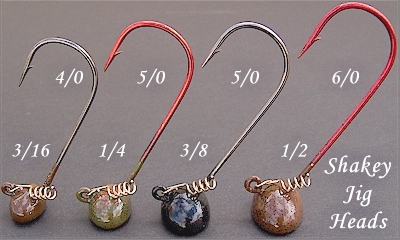
As you can see by many others out on the market today, the
basic idea of the flat football shakey stand-up jig has become
one of the most popular designs. There are so many others like it
on the market now.
Of course, shakey jigs are not rocket science but there are
detailed points to making a superlative jig that really do make a
difference - as simple as they look. There are a few significant
features I worked on that look very, very simple on mine, but a
lot of others just don't have these concepts designed into them.
The design concepts, features and actions I put in this shakey
jig are:
- Flat-Faced Design The shakey jig you see here is a
flat-faced design. The design incorporates a flat-bottomed bean
shape with rounded-off edges. You can say it's a football shape,
however the end tips of the jig head are rounded off more than
usual for a football jig. Let's say it's more of a bean shape and
flattened on the bottom, so it stands up practically straight.
With the end tips rounded off, the end tips of the jig are less
protrusive for easily moving back into the mouth when a bass
gulps or engulfs it.
- Stand Up Action The hook shank "stands up"
in order to hold the worm practically straight up off the bottom
at times. Overall, the worm falls toward bottom nose-down and
stands on the bottom with the tail up - at times - at least
momentarily. The worm is not always in this upright position.
That's often a misconception about shakey jigs, that they stand
worms up on bottom. I don't think there's any shakey jig on the
market that stands up all the time. However, the wide flat head
here facilitates the worm being in that upright posture more
often than many other shakey jig shapes out there.
- Three Point Perch Although the flat face lets this
shakey jig stand flat-footed on bottom (even if just
momentarily), it will eventually keel over as all shakey jigs
will keel over. However, due to the oblong sideways shape, this
shakey jig head resists rolling over. It won't roll over
and put the worm in the dirt as easily as does a ball jig or
other jig shape. It will often perch in a three point stance with
the hook upright, and since the wire clip is elevated above the
jig head, it keeps the worm pointing upward at a 30 degree angle.
Since the entire worm is essentially elevated or raised above the
jig head, the worm should not lay on bottom, but - this is key -
the worm will be raised slightly, elevated above bottom. The worm
won't touch dirt, making it more visible, more like a hovering
critter hunkered down close to, but not dragging its belly in the
dirt. The sideways oblong jig head will be in the dirt, and the
shank of the hook will be in the dirt - but the worm will be
elevated slightly above the dirt, with the worm tail pointing up
at about a 30 degree angle.
- Levitating Act So the worm's head is raised above the
jig head for starters since the worm head is screwed in above the
jig head. And the worm tail is raised (by the embedded hook
point) above the worm head on a 30 degree angle, even with a
non-floating worm. This is something a lot of other shakey jigs
can't do - this worm-elevating feat. The oblong head tends
to take a three point stance (the two tips of the head and the
back of the hook shank equals the three perch points). That three
point stance keeps the worm elevated above the bottom even when
the worm has fallen down and is not standing up on the flat jig
face. The three-point stance keeps the worm elevated above the
jig head and pointed upward at about a 30 degree angle. It is
almost like raising the succulent worm up to offer it to a bass!
Most other shakey jigs will roll on the side and lay the worm and
the hook point flat on bottom in the mud and muck.
- Free-Swinging Tru-Turn Hitch Hiker Clip This shakey
jig has no molded-in keeper collar. A Tru-Turn HitchHiker coil is
clipped on the eye of an extra long shank wide gap Mustad hook.
It has an Ultra Point, extra long shank, extra wide round bend.
It is a medium diameter wire that's perfect for making solid
hooksets on 6, 8 and 10 pound test. It penetrates easily on gear
in that range, and it has ample strength to land large bass
played properly on gear in that 6 to 10 pound test range. The
3/16th has a 4/0. The 1/4 a 5/0. The 3/8th and 1/2 oz both have
6/0 hook sizes, and the 6/0 enables use of 12 to 14 lb test
tackle, if need be.
- The Swinging Tree Hammock The worm is never solidly
and immovably fixed to the jig - ever. It is as if the worm is
cradled in a free-swinging tree hammock. The worm is not
permanently fixed to the jig - it is suspended in between the
wire coil and the embedded hook point. This feature sets this
shakey jig apart from other jigs that affix the worm head
immovably to a permanently molded-in coil, or that affix the worm
head using an immovable keeper collar on the hook shank.
- Mid-Water Gliding Action The flat face enhances
gliding action and causes the jig head to react more and impart
more action to the attached worm due to increased water pressure
pushing against the wide surface area of the flat face as it
glides forward. This increased pressure occurs on a slack line
fall, a semi-slack line fall or on a tight-line glide as the jig
simply pendulum swings toward the pull of the fishing line (water
resistance, even against a totally slack line will pendulum a jig
toward you) and the combined force of gravity until the jig
encounters a mid-water obstruction or reaches bottom - or gets
hit by a bass! This increased water pressure against the flat jig
face also occurs on the retrieve as the line is reeled in,
pulling the jig in with the fishing line, creating a built-in
shake as described in the next paragraph.
- Built-In Shake What's nice about this shakey jig
is it can do the shaking for you. You don't have to shake it!
What could be easier? The wide-lobed flat face of this jig is
remindful in one sense of the flat metal plate at the front of an
Arbogast Jitterbug. If you've ever seen the Jitterbug, you know
that metal plate (which looks like the flat front of this shakey
jig) makes a Jitterbug wiggle and shake back and forth. Now, the
shakey jigs here have nowhere near the vigorous side-to-side
thrashing of a surface-crawling Jitterbug, but the wide flat
front of this shakey jig does have the same sort of effect (but
less pronounced) on a finesse worm. The shake starts in the head
and ripples through the worm body, causing the tail to vibrate
and shake as the worm falls, is lifted or retrieved. It causes a
finesse worm to shake, shudder, wiggle and woggle unpredictably.
The action changes constantly. The action is never the same
twice. Sometimes it is just a tail shiver or shudder and next
moment it's almost an S-shaped eel-like wriggle. This
unpredictable, non-repetitive action is highly attractive to
fish. It is more life-like than the repetitive mechanical
movement most lures make. Not every worm model does this the same
(get shaken by the jig), some do better than others. Try a few.
- Lifting Action The angled face plate also causes lift,
and that's a very good thing. Constant rising off bottom and
settling back to bottom are what small fish, crawdads and other
bottom creatures do constantly. It's their major mode of
movement. Most do not just drag their carcasses across the
bottom. The lifting and falling glide of this flat football jig
mimics the most common rise-and-fall movements of all bottom
creatures.
- Slamming Action As this flat-faced jig lifts off
bottom, it does not lift too far and it will pendulum-swing
toward the pull of the fishing line. So it swings forward and
slams the flat face plate head-on into any hard objects that are
raised slightly higher than the surrounding bottom. This sudden
full frontal impact shock concussion - or "slamming"
action is an incredible strike trigger.
- Climbing Action Some anglers do not like flat football
jig heads as much as fully round-bottomed football jigs.
They like how the standard, round-bottomed football jigs roll
over rugged bottom and they feel that flat football heads lose
some of that ability to roll over and therefore make it across
rugged bottom. It's true that many other brands of flat football
jigs drive or force the flat surface to grind constantly against
the bottom, and that creates a constant struggle or difficulty to
move other flat-faced jigs forward (compared to round-bottom
football jigs). Quite simply, my shakey jig is designed to stand
up semi-vertically when brought to rest, as it noses down. When
pulled forward, it noses up, and reverts to a horizontal posture,
and the angle of the flat face no longer lays flat so it doesn't
grind (instead it's angled to climb) over rugged bottom. It will
even climb through brush amazing swell! The flat face of my jig
(and the line tie pull point) are designed so it climbs
effortlessly over rugged bottom and through brushy cover.
As you may realize now, there is more to my flat-face jig design
than just standing up on the bottom!
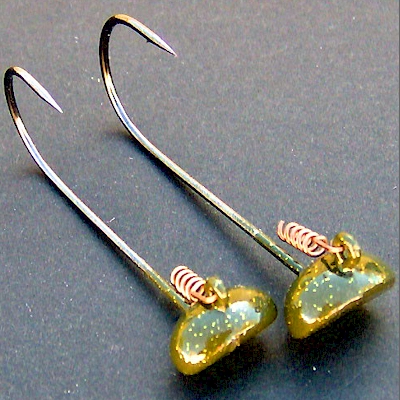
Three Point Perch: Even when they tip over, they perch
in a three point stance which tends to keep the hook upright. The
three points are the two tips of the sideways oblong head and the
back end of the hook shank. The jig won't always keep in this
position, and it will roll over on rugged, uneven bottom - but it
rolls on its side far less than other jig shapes. Most other
shakey jig shapes cannot maintain this kind of three point stance
that keeps the worm and hook pointing upward and out of the dirt.
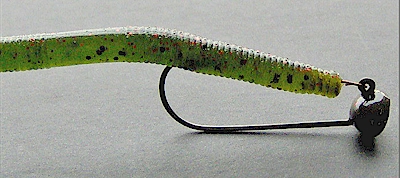
Levitating Act: This shakey jig will often remain with
the hook upright, and since the worm is held levitated above the
jig, it keeps the worm pointing upward, raised above the muck
where it's visible and looks natural.
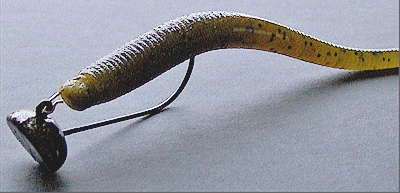
Swinging Hammock Action and Independence: Since it is
not affixed to the jig head, the worm remains as flexible and
unfettered and independent as possible on the shakey jig.
Give them a try! Most anglers who have, they tell me like
them.
Importance of the Initial Fall
Most brands of finesse worms will shake and squiggle to some
degree on the initial fall toward bottom. Your worm will often
get belted before it even reaches bottom. When a worm does hit
bottom, it is often an abrupt stop, and the tail of the worm
still wants to keep going even after the head has stopped. This
makes the worm act as if it's been stunned by the bottom impact.
Keep in mind, since this is a broad bean shape head, it will keep
your worm perched atop the bottom and out of snags that would
otherwise engulf and bury ball head or other jig head shapes.
Most often, the jig here will stand the worm up initially after
its been stunned by the impact, and then some additional body
movement tends to happen as the worm folds over in half or slowly
lays down. Between the squiggling initial fall, the sudden
stunned convulsion as it hits the bottom, standing up and then
keeling over after a momentary pause, there's not much else you
need to do here at times except set the hook and reel in the
fish!
If there is no hit during the initial fall, additional lifts
and drops and hops all cause finesse worms to shake and shudder
and swim unpredictably, never the same way twice as they are
raised a few feet up and then allowed to fall back to bottom.
Even on a steady retrieve, finesse worms tend to squirm and swim
when retrieved at a moderate speed on this shakey jig. On the
retrieve, while the worm is swimming back to you, you can throw
in jerks and pops and pauses just like you would retrieve a hard
plastic lipped jerkbait, and this jig head will cause the finesse
worm to act like a jerkbait does. It is the unpredictable and
non-repetitive pattern of shakes and shimmies that causes this
jig head to be truly great, and to fool fish into thinking the
worm is alive. It does look alive. It's not a mechanical
repetitive movement like a wide-wobbling crankbait. You can
perhaps say it is more like a tight-swimming hard plastic lipped
jerkbait, except this shakey jig starts and stops, at first a
tight shudder, then suddenly more of a wiggle, and never quite
the same way twice. This is exactly the unpredictable
start-and-stop, fast burst then slow glide series of moves a live
baitfish would make.
The description above, that is the best way to fish this
shakey jig since it does the shaking for you on the initial fall
and when you lift and drop it. Keep in mind, you want to maximize
or facilitate this jigs ability to do the shaking for you. So how
you let it drop, lift and fall or retrieve should all be aimed at
getting the shakey jig to shake the worm itself. There's a little
knack to getting the jig to activate that built-in shake, but
with a little practice, you'll learn how to do it. Additionally,
you can also use any of the tactics used with any other shakey
jigs. You can shake the rod as it falls. Shake it as it's on the
bottom. Drag it without shaking. You can do absolutely nothing as
it falls and deadstick it on bottom for what seems like forever.
You can cast out, engage the reel, and let it pendulum arc back
to you through the water column. Especially to pendulum down
roughly following a sloping bottom structure is an easy,
surprisingly effective, yet little-used technique. We already
describe swimming it back to you, throwing in an occasional rod
flick, or simply swim it straight and steady. What you want is
for it to squiggle unpredictably as it swims.
Overall, the biggest misconception about shakey jigs is you
need to shake them. You do not. You could never shake a shakey
jig even once, and still catch as many or more fish as those who
shiver the spit out of them. It's the same thing often said how
to fish a dropshot rig, to shake it. Yet I've never shaken a
dropshot yet, and catch as many or more fish than those who shake
it. Yes, shaking a shakey jig (or dropshot) will catch fish, even
win tournaments, but don't feel obligated to shake it. Be
versatile.
About the Clip-on Wire Corkscrew Keeper
A separate corkscrew keeper coil is used to clip to the hook
eye. You screw the worm head on, and then the super sharp point
of the extra long shank hook can be buried and hidden Texas-style
within the worm. Now you're ready! There's really no reason to
ever unclip the coil, but if you do, spread the clip loop open
slightly with your thumbnail to remove it. Squeeze the clip loop
closed again with your thumbnail once you clip it on again. It
should never really come off (squeeze it shut) and it does not
interfere with the fishing line or knot. Best of all, a worm
cannot easily be pulled off the keeper coil by a fish, and the
coil does not tear a worm up as much as other barbed keeper types
or jig head collars. It truly is a great approach!
The free-swinging coil also helps the worm shake by itself.
There is not much of the worm body that is fixed or
"frozen" by this set-up. The corkscrew coil goes into
the head only about 1/4" is all, yet it holds the worm more
securely than most anything else. Only 1/4" of the worm is
fixed, and then the small section where the hook point is buried
in the worm. The entire rest of the worm body is free to squirm,
not threaded on the jig hook, and since the coil itself is
loosely clipped on instead of fixed immovable on the jig, the
worm is really held in free-floating suspension, so it can squirm
and shake more than on other types of shakey jig heads.
A Few Words on Worms
Sjakey jig heads are first and foremost used with finesse
worms. Long, slender worms in the 5 to 6 inch range seem to shake
the best with the 1/4 and 3/8 oz size shakey jig heads.
Smaller 4 inch worms can be rigged on the 3/16 oz size. The 3/16
oz size is better matched to 6 to 8 pound test and a slightly
more limber rod. The 1/4 oz size is suitable for a range of 6 to
10 pound test. The 3/8 oz size fits best with 8, 10 and even 12
pound test.
Different brands and models of worms act differently. It is
well worth it to experiment to see the different shakes, shimmies
and squiggles that different brands, sizes and styles of worms
will make on this Shakey Jig head. You should try your favorites
to see how they perform.
- One particular worm that works well is Gary Yamamoto's
5" Pro Senko (9P model). The 9P Senko has a more fluid
S-shaped motion on this Shakey Jig. When you hop and pop it
across the bottom, it almost looks like a live worm squirming in
the water. Very natural and strike-provoking!
- A second great worm for the 1/4 and 3/8 oz size shakey
jig is Yamamoto's 5-3/4" Kut Tail Worm (7C model). The 7C
Kut Tail has more of a tight quiver and tail ripple as it free
falls, is lifted or hopped.
- A third worm is Yamamoto's 5" Kut Tail Worm (7L model).
The 7L is long, slender and shakes it's tail as it falls on a
slack line, is lifted and dropped.
- The 3/16 oz size shakey jig head will work with the
aforementioned worms which are 5 inches or longer. The 3/16 oz
head will give these worms a slower fall than the 1/4 to 3/8 oz
head. Importantly, the 3/16 oz is the preferred size for smaller
4" worms such as Yamamoto's 4" Slim Senko (9J model) or
4" Kut Tail Worm (7-series) and other worms in the 4"
size category using 6 to 8 pound test line.
- When other anglers are catching bass on dropshot rigs, that's
one prime time to use the shakey jig. Simply use the same worm as
on a dropshot, but don't be surprised if some days you catch more
fish with the same worm Texas-rigged on this shakey jig.
- Now here's a good tip and one of the lesser-known
secrets of shakey jig. It is considered to be a finesse worm,
small, slender worm and light tackle technique. Guys take that as
a given, and even top pros don't step up out of the small worm
light tackle mindset with a shakey jig. Indeed, some of the top
tournaments in the country have been won using light tackle (6-8
pound test), light shakey jigs and little worms. But it doesn't
need to be that way. Do the math. If you use smaller worms, odds
are you'll catch smaller bass. If you use bigger worms, odds are
in your favor that bigger bass will bite them. It's that simple.
The 1/4 and 3/8 oz shakey jigs have a stout enough 5/0 hook in
order to handle thicker 6 to 7 inch plus worms on 10 to 12 pound
test. Worms like Yamamoto's meaty 6-1/2" Kut Tail (7X
model) are deadly this way. Not all shakey jigs on the market
have the beefy hook to handle this, but the 3/8 and 1/4 oz shakey
jigs here have it.
Shaking with Other Soft Plastic Shapes
Of course, the shakey jig's not just limited to worms. You can
Texas rig craws, tubes, grubs, hula grubs, lizards or most any
other soft baits on this Shakey Jig. See for yourself if
this isn't one of the best 6 to 10 pound test range jig head
applications you've ever used - bar none. And best of all, it's a
jig tactic but the bait is Texas rigged to be weedless and
snagless.
No matter what soft bait shape you use, the results may often
be "flat" out too much fun with Bassdozer's Flat Shakey
Jigs rigged with many different soft baits.
Rigging Methods
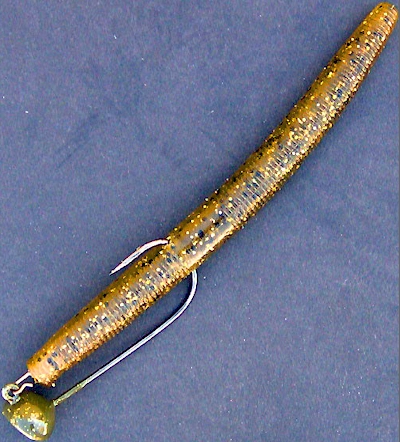
Open Hook Rigging Method. Yamamoto 4" Senko
(9S-series). In open water areas, rig with hook freely exposed
for best hooksets.
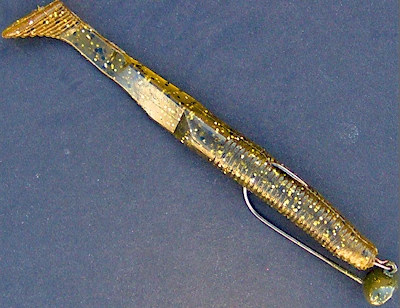
Tex-Exposed Rigging Method. Yamamoto 4" Swimming
Senko. The hook point is nestled tightly right on top of the
worm, making it relatively snag-free.
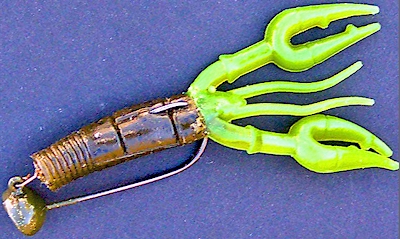
Tex-Skin Rigging Method. The hook point is tucked back in
barely beneath the bait's skin. The point won't pick up weeds but
it will pull out from under the plastic skin easily when a fish
nips it.
|
